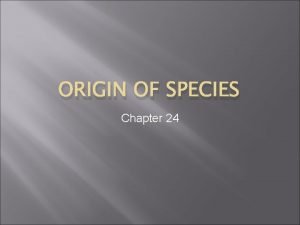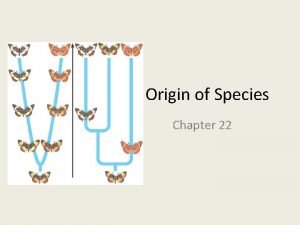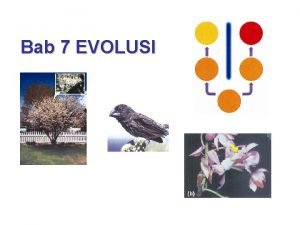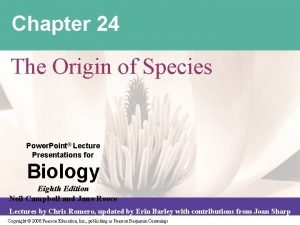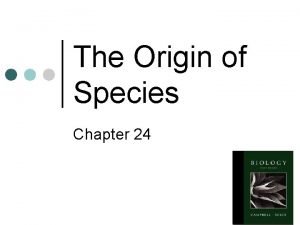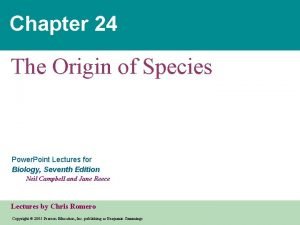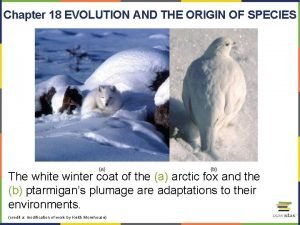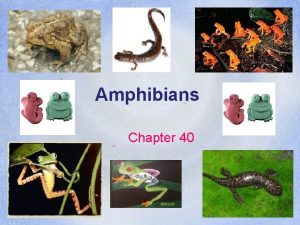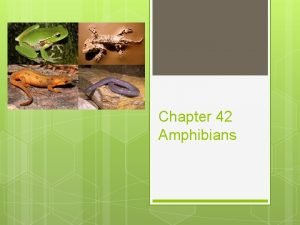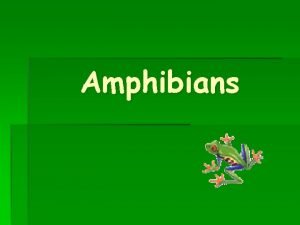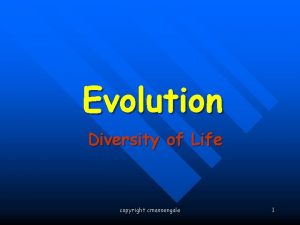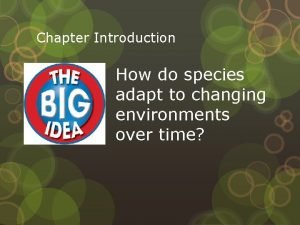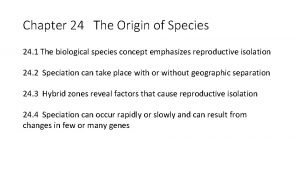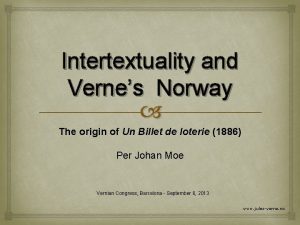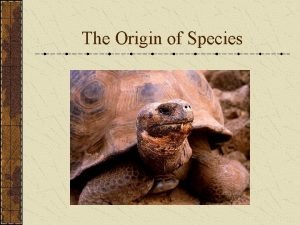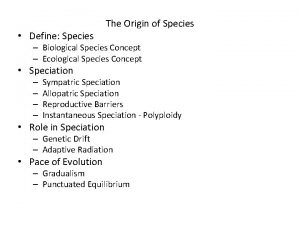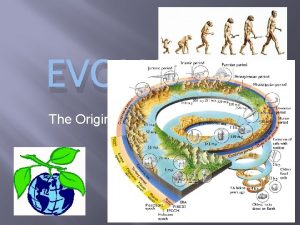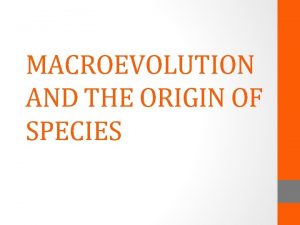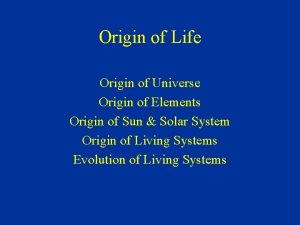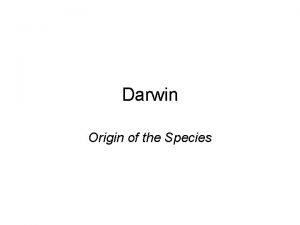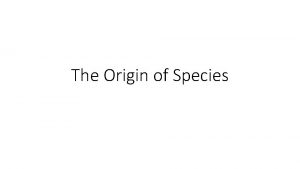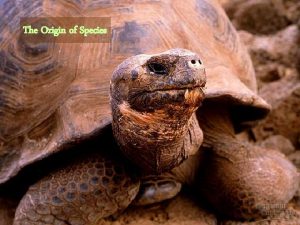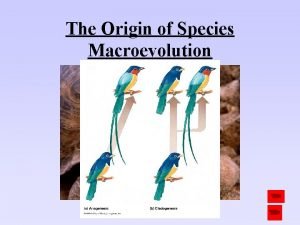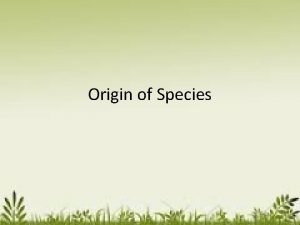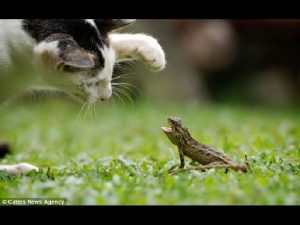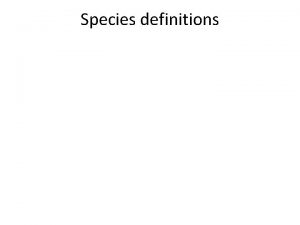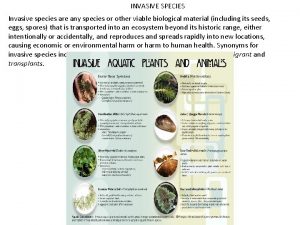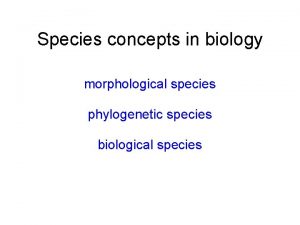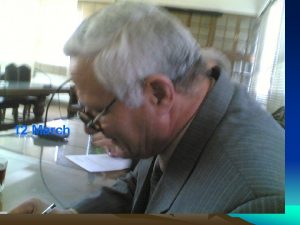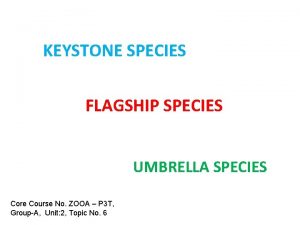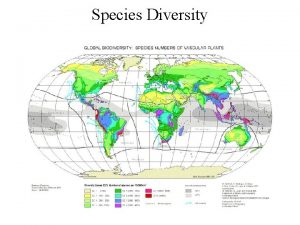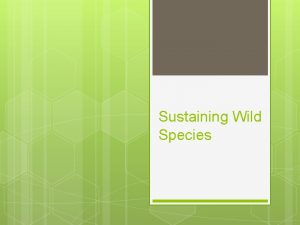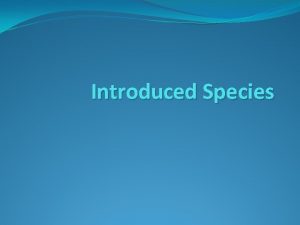Chapter 18 EVOLUTION AND THE ORIGIN OF SPECIES































- Slides: 31

Chapter 18 EVOLUTION AND THE ORIGIN OF SPECIES The white winter coat of the (a) arctic fox and the (b) ptarmigan’s plumage are adaptations to their environments. (credit a: modification of work by Keith Morehouse)

ADAPTATION All organisms are products of evolution adapted to their environment. . FIGURE 18. 1 The Andean semiaquatic lizard (Potamites montanicola) discovered in Peru in 2010 lives between 1, 570 to 2, 100 meters in elevation, and, unlike most lizards, is nocturnal and swims. Scientists still do no know how these cold-blood animals are able to move in the cold (10 to 15°C) temperatures of the Andean night. That is not to say that Nature is perfect. Environment and conditions for a species change. Which is one reason that they are continually EVOLVING. (credit a: modification of work by Gentry George, U. S. Fish and Wildlife Service; credit b: modification of work by Germán Chávez and Diego Vásquez, Zoo. Keys)

EVOLUTION AS DESCENT WITH MODIFICATION FIGURE 18. 2 Charles Darwin observed that beak shape varies among finch species. He suggested that the beak of a colonizing ancestral species had diversified and adapted over time to equip different finch populations to acquire different food sources. Over time, they became different species. © John Gould (public domain) and ©M. Minderhoud (public domain)

WHAT IS EVOLUTION? Biological change over time in a population of organisms (note: populations evolve, not individuals) It can occur through 5 mechanisms: 1. Natural Selection (survival of the fittest) In this chapter we focus on Evolution by Natural Selection and how it can lead to Speciation 2. Sexual Selection (survival of the hottest) 3. Gene Flow (alleles migrate from one population to another) 4. Mutation (new alleles form due to chemicals, radiation, or error) 5. Genetic Drift (change in allele freq. due to random events) due to a. Random inheritance of alleles (always occurring due to meiosis) b. Founder Effect (a small subset of a population forms a colony) c. Bottleneck Effect (a few survivors of a die-off form a new population)

By studying biodiversity in the Amazon, Alfred Wallace also postulated Natural Selection as a mechanism for species diversity. Darwin realized Wallace would scoop him, and so they co-published, (23 years after Darwin developed the idea of natural selection). FIGURE 18. 3 Both (a) Charles Darwin and (b) Alfred Wallace wrote scientific papers on natural selection that were presented together before the Linnean Society in 1858. They proposed a mechanism for evolution that worked. It had a mechanism…Natural Selection.

WHY WAS DARWIN SO CAUTIOUS TO PUBLISH? So that he didn’t end up penniless and disgraced like Jean-Baptiste Lamarck, the first person to propose a mechanism for how Evolution may proceed. * Lamarckian evolution suggested that the efforts of an individual could affect a characteristic where effort was applied and be transferred to the offspring. So, for example…the giraffe’s neck grew from its ancestors short necks by their efforts to reach higher leaves in trees. Natural Selection effort Darwin and Wallace proposed a mechanism for evolution to work that was logical and supported by evidence, …Natural Selection. *Suggestions that species change into other species over time had been proposed even back in ancient Greece ( the earliest known: Anaximander, circa 2550 years

NATURAL SELECTION Traits which offer an advantage become more common in a population over time. Why? They offer greater FITNESS (defined as the tendency to lead to an individual reproducing more than others of its population which lack the trait). If such a trait resulted in the carriers of the trait being better suited to their conditions, it would be an adaptation Examples: 1. Traits which increase hunting ability (for a predator) 2. Traits that increase the ability to escape (for prey) (e. g. camouflage, incr. speed) 3. Traits that decrease a predator’s likelihood to successfully attack (incr. size or horns) 4. The lack of a trait which is detrimental to survival (e. g. lacking a genetic disease) 5. Increased immunity to bacteria or viruses (pathogens)

WHAT IS REQUIRED FOR NATURAL SELECTION 1. Some level of variability in traits in a population A. And thus some genetic variability must exist B. Sexual recombination, mutation and gene flow support variability 2. A difference in the fitness of traits (aka differential fitness) A. Thus there can be some individuals with a fitness advantage B. Competition for survival and mates can work with difference existing 3. Heritability of traits A. Today we take it for granted that children share some characteristics from their parents due to the inheritance of their DNA B. But Darwin didn’t know about DNA so…he had to make this assertion using examples from animal breeding. Actually, Darwin used animal breeding as evidence also for how selection works…

ARTIFICIAL SELECTION Darwin explained that the same heritability and selection which humans exploit in animal breeding (artificial selection), are used by nature as environmental conditions select for particular traits that benefit the organism’s fitness. Humans have selected the characteristics of a (a) poodle and (b) cocker spaniel and then allowed them to reproduce to produce a breed known as (c) the cockapoo. . (credit a: modification of work by Sally Eller, Tom Reese; credit b: modification of work by Jeremy Mc. Williams; credit c: modification of work by Kathleen Conklin)

IN NATURE, COMPETITION SELECTS FOR FITNESS Between individuals of a population for food and resources (even light) Between species for food Amongst males/females for mates Although this is also sexual selection © Martin Cathrae (public domain) © Marie and Allstair Knock (public domain) or species for food/resources © U. S. Navy (public domain) © U. S. National Park Service (public domain)

SO WHAT DOES FITNESS MEAN? It is how well you are suited to survive as evidenced through reproduction. How FIT would this pangolin be if it had fewer scales? The higher number and strength of its scales confer greater fitness. The individual, the characteristic (more scales), and the alleles that generate the characteristic all have high FITNESS. But in order to demonstrate that fitness, ultimately it must reproduce (over generations) more than other individuals who lack this trait. (c) Sandip Kumar (public domain)

HOW CAN WE OBSERVE EVOLUTION 1. Fossil Record A. Using Radioisotope Dating of fossils to understand the record B. Comparing the anatomy of living (extant) and extinct species 1. Observing homology (similarity due to common ancestry) 2. Over 250, 000 extinct species known only from fossils 3. Embryological similarity often results from common ancestry. 2. Direct observation of physical changes in populations over time 1. In the wild it can take time, but people do it 2. In the lab it can be seen using rapidly reproducing species 3. Using DNA 1. Changes in allele frequencies in population over time 2. Comparing extant and extinct species in DNA similarity/differences

FOSSIL RECORDS (a) An artist’s rendition of (b) extinct species of the genus Equus reveals that these ancient species resembled the modern horse (Equus ferus) but varied in size. The evolution of horses is shown by one of the most complete fossil records known for terrestrial vertebrates. The smallest and earliest ancestor shown (Hyracotherium) had 5 toes, which ultimately evolved into the single toed horse of today. (public domain)

COMPARATIVE ANATOMY FIGURE 18. 7 HOMOLOGY: (same origin) the similar construction of these appendages indicates that these organisms share a common ancestor. Embryological analysis of these features can show their common tissue origin as well. Rights: Wikipedia free media repository (public domain)

Ernst Haekel famously stated “Ontogeny recapitulates phylogeny” which means the development of the organism should reflect its evolutionary classification, thus the embryo should carry the features of its ancestors, and these characteristics should appear in their order of appearance in the fossil record. Gills for example develop early for land vertebrates Because they developed early in Chordate evolution Limbs develop later From Haekel (public Domain)

Ontogeny does not recapitulate Phylogeny in ALL cases, however, because evolution sometimes selection sometimes favors changing the embryological state, though such changes pose risks to development, and are thus less common. BUT, Embryological homologies are difficult to explain without evolution. They match well with DNA based phylogeny. The genes responsible for the homologies in embryos form show common origin as well between species.

CONVERGENT EVOLUTION ANALOGOUS: When similarity of form is due to similar evolutionary pressures but NOT common ancestry. Suggests similar biological answer to similar selective forces, because form follows function. From Atsushi Ogura, Kazuho Ikeo, and Takashi Gojobori (2004) Cold Spring Harbor Press.

SPECIATION POPULATIONS DIVERSIFY OVER TIME TO FORM SEPARATE SPECIES THAT SHARE COMMON ANCESTRY FIGURE 18. 5 Notice that the (a) dense blazing star (Liatrus spicata) and the (b) purple coneflower (Echinacea purpurea) vary in appearance, yet both share a similar basic morphology because they share a recent common ancestor. (credit a: modification of work by Drew Avery; credit b: modification of work by Cory Zanker)

ADAPTIVE RADIATION These honeycreeper birds illustrate adaptive radiation. From one original species of bird, multiple others evolved, each with its own distinctive characteristics. LOTS OF SPECIATION FIGURE 18. 13 When the dinosaurs died 65 mya, mammals Underwent adaptive radiation as many ecological newly vacant Ecological niches opened up for them. Many new species resulted. The Galapagos, as new volcanic islands became colonized by mainland animals, much speciation followed.

SPECIATION What defines a species? A group of individuals which is able to interbreed successfully (which necessitates reproducing to make fertile viable offspring) This is the Biological Species Concept Other species concepts exist (which are more inclusive and have a less stringent and clear test of the species boundary). So for this discussion of speciation as it relates to evolution we will use the Biological Species Concept All One Species Using the Biological Species Concept. (credit a: modification of work by Sally Eller, Tom Reese; credit b: modification of work by Jeremy Mc. Williams; credit c: modification of work by Kathleen Conklin ) and Pixabay (creative commons)

FIGURE 18. 11 The only illustration in Darwin's On the Origin of Species is (a) a diagram showing speciation events leading to biological diversity. (a phylogenic tree) The diagram shows similarities to phylogenetic tree diagrams that are drawn today to illustrate the relationships of species. (b) Modern elephants evolved from the Palaeomastodon, a species that lived in Egypt 35– 50 million years ago.

ALLOPATRIC SPECIATION This means that species form as a result of a physical barrier (or distance). The northern spotted owl and the Mexican spotted owl inhabit geographically separate locations with different climates and ecosystems. They can still interbreed and produce viable fertile offspring, . . These owl populations are undergoing incipient speciation (changes that will likely result in speciation if they remain separated). (credit “northern spotted owl”: modification of work by John and Karen Hollingsworth; credit “Mexican spotted owl”: modification of work by Bill Radke) FIGURE 18. 12

SYMPATRIC SPECIATION FIGURE 18. 17 These two related frog species exhibit temporal reproductive isolation. (a) Rana aurora breeds earlier in the year than (b) Rana boylii. So time and not Space is what separates these species. (credit a: modification of work by Mark R. Jennings, USFWS; credit b: modification of work by Alessandro Catenazzi)

FIGURE 18. 18 Speciation can occur when two populations occupy different habitats. The habitats need not be far apart. The cricket (a) Gryllus pennsylvanicus prefers sandy soil, and the cricket (b) Gryllus firmus prefers loamy soil. The two species can live in close proximity, but because of their different soil preferences, they became genetically isolated.

Sometimes speciation takes place when two (or more) populations of a species occupy the same location, but begin to use different ecological niches. SYMPATRIC SPECIATION Their gene pools must separate from one another if speciation is to occur. Different mating rituals, sex organs, time of activity, or other behavioral differences can help REINFORCE the separation between gene pools. Otherwise a Hybrid Zone (where the two populations interbreed) can be produced.

GENE POOL The collection of all the genetic variants in a species. So if a species is the set of all of the successfully interbreeding individuals or all of those capable of it, then the gene pool is the set of all of the individuals in the species and all of their alleles. If enough mutations accumulate in each group, (usually over millions of years) they will not be able to successfully interbreed anymore. For Speciation to happen, the gene pool has to split up so that to (or more) populations stop interbreeding with one another. 1. 2. Eventually, with time, each group 3. will accumulate mutations not found in the other. As mutation is a random process, the time required for speciation varies greatly. Reasons: Incompatibility of Homologues during Meiosis Incompatible sexual maturation processes Incompatible ligands and receptors

FIGURE 18. 19 The shape of the male reproductive organ varies among male damselfly species, and is only compatible with the female of that species. Reproductive organ incompatibility keeps the species reproductively isolated.

PUNCTUATED EQUILIBRIUM VS GRADUAL SPECIATION PUNCTUATED: If successive major events have a significant impact on the speciation over time, (successive significant jumps in speciation) GRADUAL: If the processes leading to speciation occur at a slow and steady rate over time.

A LACK OF IDENTICAL SECTIONS OF DNA ON HOMOLOGOUS CHROMOSOMES DURING MEIOSIS CAN CAUSE AN INTERBREEDING EVENT TO LEAD TO NONDISJUNCTION AND ANEUPLOIDY Most Aneuploid animal offspring do not live. Often plants can live when aneuploid (polyploid) FIGURE 18. 14 Aneuploidy results when the gametes have too many or too few chromosomes due to nondisjunction during meiosis. In the example shown here, the resulting offspring will have 2 n+1 or 2 n-1 chromosomes

IF ANEUPLOID OFFSPRING DO LIVE, … SUCCESSIVE MATINGS CAN PRODUCE VIABLE GENETICALLY STABLE HYBRID OFFSPRING FIGURE 18. 16 Alloploidy results when two species mate to produce viable offspring. In the example shown, a normal gamete from one species fuses with a polyploidy gamete from another. Two matings are necessary to produce viable offspring.

REINFORCEMENT OF SPECIATION CAN HAPPEN IF ANIMALS CHOOSE DIFFERENT SYMBIOTIC RELATIONSHIPS HERE TWO FLOWER SPECIES SEPARATED BY DEVELOPING DIFFERENT POLLINATOR RELATIONSHIPS SYMPATRIC OR ALLOPATRIC? Some flowers have evolved to attract certain pollinators. The (a) wide foxglove flower is adapted for pollination by bees, while the (b) long, tube-shaped trumpet creeper flower is adapted for pollination by humming birds.
 The origin of species manhwa chapter 24
The origin of species manhwa chapter 24 Chapter 24 the origin of species
Chapter 24 the origin of species The origin of species manga 22
The origin of species manga 22 Evolusi weismann
Evolusi weismann Chapter 24 the origin of species
Chapter 24 the origin of species The origin of species manga 24
The origin of species manga 24 Chapter 24 the origin of species
Chapter 24 the origin of species Origin of species - chapter 18
Origin of species - chapter 18 Can plants be keystone species
Can plants be keystone species Origin and evolution of amphibia
Origin and evolution of amphibia Origin and evolution of amphibia
Origin and evolution of amphibia Origin and evolution of amphibia
Origin and evolution of amphibia Frog respiratory system
Frog respiratory system Geographic distribution of species evolution
Geographic distribution of species evolution Evolution of species 2
Evolution of species 2 The origin of species manga 24
The origin of species manga 24 The origin of species bl
The origin of species bl Origin of species by charles darwin
Origin of species by charles darwin Niches biology
Niches biology Hát kết hợp bộ gõ cơ thể
Hát kết hợp bộ gõ cơ thể Lp html
Lp html Bổ thể
Bổ thể Tỉ lệ cơ thể trẻ em
Tỉ lệ cơ thể trẻ em Chó sói
Chó sói Chụp phim tư thế worms-breton
Chụp phim tư thế worms-breton Alleluia hat len nguoi oi
Alleluia hat len nguoi oi Các môn thể thao bắt đầu bằng từ đua
Các môn thể thao bắt đầu bằng từ đua Thế nào là hệ số cao nhất
Thế nào là hệ số cao nhất Các châu lục và đại dương trên thế giới
Các châu lục và đại dương trên thế giới Công thức tính độ biến thiên đông lượng
Công thức tính độ biến thiên đông lượng Trời xanh đây là của chúng ta thể thơ
Trời xanh đây là của chúng ta thể thơ Cách giải mật thư tọa độ
Cách giải mật thư tọa độ

